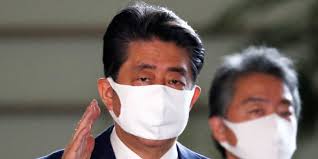World
Japanese PM aims at new targets, rise in GDP

Tokyo: Japanese Prime Minister Shinzo Abe announced that he has set out three new goals for “Abenomics” and will target a 20 percent increase in gross domestic product, the media reported.
The three new economic policy goals are: promotion of economic growth, child-rearing assistance to push up the low birth rate, and social security measures to increase nursing facilities for the elderly, as per reported.
“For the next three years, I’d like to promote measures with an eye on the future. Today Abenomics is entering its second phase,” Abe said on Thursday.
Abe also said his government will aim to increase Japan’s nominal GDP by about 20 percent and keep the population at around 100 million.
Abe vowed to increase the number of intensive care nursing home facilities to tackle waiting lists as a result of a rapidly aging population. The government plans to include expenses for increasing the number of nursing homes in the budget for fiscal 2016.
It will aim to bring some 150,000 people currently on the waiting lists, who are certified as being in need of Level 3 care or above on a scale of 5, to zero by early next decade. Level 3 under Japan’s public nursing system is applied to elderly people who are deemed to be unable to care for themselves but can be treated at home.
With this fresh mandate, Abe is expected to reshuffle his Cabinet and the LDP executive team next month, aiming to ameliorate declining public support following the passage of contentious national security bills last week.
By re-emphasizing his economic agenda, Abe is apparently trying to recover his popularity among voters and market players.
Polls have suggested more than half of voters are opposed to Abe’s security reform drive, and opposition parties are ready to attack the LDP over the issue leading up to the Upper House election next summer.
Asked if the LDP will advocate any revision of the post-war constitution during the election campaign, Abe said at Thursday’s news conference that he and the Liberal Democratic Party will first try to promote “understanding of the nation.”
World
Lockdowns in China Force Urban Communities to Defy Censorship and Vent Frustration Online

Shanghai’s rich middle class is leading a wave of online dissent over the strict and prolonged lockdowns imposed in various parts of the country. Chinese internet censorship is struggling as patience is wearing thin in many urban centers, coming up with creative forms of online protests.
Social Media Posts Revealing Lockdown Tension in Shanghai
Drawn-out lockdowns are nothing new in China as authorities insist with the nation’s zero-Covid policy since the start of the pandemic. Currently over This time around, however, metropolitan areas like Shanghai are increasingly difficult to keep quiet, given that its more than 25 million residents have seen weeks of total isolation along with food shortages and many other service interruptions.
Dozens of towns and reportedly over 300 million Chinese citizens have been affected by lockdowns of different severity. As expected, urban netizens have been most outspoken over their difficulties by finding creative ways to get around state censorship and bans placed on topics, news comments and spontaneous campaigns.
Shanghai residents have been using mobile proxies and hijacking seemingly unrelated hashtags to talk about healthcare issues, delivery failures and the overall severity of their situation. The “positive energy” that the Chinese government wants to transmit during the recent prolonged series of lockdowns does not come naturally to those counting food supplies and online censors are working hard to filter words, trending topics and undesired social media sharing.
WeChat groups and message threads are under constant monitoring. Posts questioning the zero-Covid approach have been quickly deleted, including by leading Chinese health experts like Dr. Zhong Nanshan. Video footage is soon censored and protests and investigations are quickly made to disappear.
Where this has not worked, officials have exposed banners with warnings and outright threats like “watch your own mouth or face punishment”, while drones have been patrolling the city skies. Yet, if anything, this has led to further tensions and unspoken confrontation with Shanghai’s educated and affluent middle class.
Creative Online Solutions Harnessing Civic Energy
Announcements by Chinese social media that they would be publishing the IP addresses of users who “spread rumors” have not helped either. Tech industry research has shown that much of Asia’s tech-savvy population has a habit of using mobile proxies and other privacy tools, quickly finding workarounds to browse the internet freely and talk to the world about the hottest topics.
The sheer volume of forbidden posts is already a challenge for the very censorship system, experts explain. Unable to track all trending hashtags, state workers overlook topics that speak about the US, Ukraine or other popular news. Linking human rights elsewhere to their situation, Chinese online dissidents establish their informal channels and “hijack” the conversation to share personal or publicly relevant information about the Covid suppression in their town.
Sarcastic and satirical posts still dominate. Others hope to evade the censors by replacing words from famous poems or the national anthem. One thing is certain – social media, when harnessed with the right creativity, has proven its ability to mount pressure on the government in even some of the most strictly controlled tech environments like China.





















